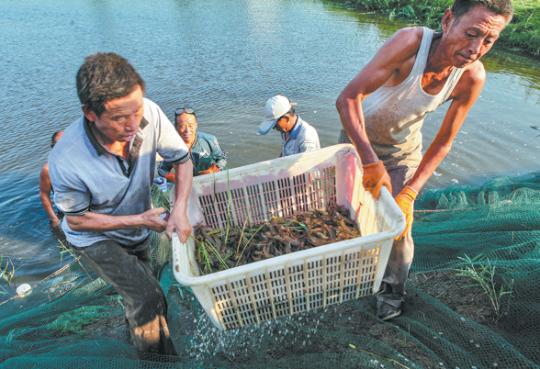In Boxing county, located in Shandong province, expanses of previously unusable saline-alkaline soil have been converted into a flourishing hub for modern aquaculture. By leveraging low-lying areas along the Yellow River, local authorities have turned ecological constraints into economic advantages through coordinated development.
Over recent years, the county has rapidly advanced the transformation of unproductive land by constructing standardized fishponds, industrial-scale farming facilities, and essential support systems such as irrigation networks, roads, and electricity grids, forming integrated aquaculture zones.
Qiaozhuang town emerged as a leader in this transformation, beginning experimental shrimp farming as early as 2001. Farmers developed a method of blending freshwater from the Yellow River with naturally saline groundwater, gradually acclimating shrimp to the unique conditions.
“Our village is built on former coastal land with high salinity, where only wild grass could grow and crops struggled to survive. We used to be synonymous with poverty,” said Song Chun, Party secretary of Wangping village in Qiaozhuang.
“Now, almost every household is involved in shrimp cultivation, and living standards have improved significantly,” he added.
Over the past two decades, Qiaozhuang has established a comprehensive production chain covering seedling adaptation, feed distribution, disease prevention, cold storage, processing, and market sales.
“On average, each family manages two or three shrimp ponds, earning over 100,000 yuan ($14,055) annually,” Song noted.
The town continues to adopt technological innovations, including an automated recirculating aquaculture system that handles feeding, waste collection, and harvesting. A real-time digital monitoring platform tracks vital water parameters such as temperature and dissolved oxygen levels, ensuring optimal conditions for aquatic life.
According to local government data, Qiaozhuang now operates 38,000 mu (approximately 2,533 hectares) of shrimp ponds, yielding an average annual income of 17,000 yuan per mu.
Wang Jingdong, deputy head of the Shandong Provincial Department of Agriculture and Rural Affairs, outlined the region’s broader strategy: “We follow an integrated model that balances grain, cash crops, and forage production, while advancing agriculture, livestock, and fisheries simultaneously. Through the development of specialized saline-alkaline farming, we are transforming what was once a ‘wasteland’ into a source of valuable economic returns.”
— news from ecns.cn
— News Original —
Aquaculture reels in economic opportunities
2025-11-24 China Daily Editor:Zhang Dongfang n nIn Boxing county, Shandong province, vast stretches of once-barren saline-alkaline land have been transformed into a thriving modern aquaculture base. Through coordinated development of low-lying areas along the Yellow River, the county has turned ecological challenges into economic opportunities. n nIn recent years, Boxing has accelerated the large-scale conversion of these unproductive lands, built standardized ponds, industrial aquaculture facilities, and supported infrastructure including water conservancy systems, roads and power supply networks to establish integrated modern fisheries zones. n nA pioneer in this effort, Qiaozhuang town began experimenting with shrimp farming as early as 2001. By mixing Yellow River water with local saline groundwater, farmers gradually adapted the shrimp to the local conditions. n n”Our village sits on reclaimed coastal land which is highly saline, where only weeds grew and crops barely survived. We were once known for poverty,” said Song Chun, Party secretary of Wangping village in Qiaozhuang. n n”Now, nearly every household raises shrimp, and lives have improved dramatically,” he said. n nOver the past two decades, Qiaozhuang has established a complete industrial chain from seedling acclimation, feed supply, and disease control to cold storage, processing, and sales. n n”On average, each household in our village manages two or three shrimp ponds, with annual earnings exceeding 100,000 yuan ($14,055),” Song added. n nThe town continues to innovate. It has introduced an intelligent recirculating aquaculture system that automates feeding, waste removal, and harvesting. An online water-quality monitoring system tracks key indicators, such as water temperature and dissolved oxygen in real time, ensuring a healthy aquatic environment. n nToday, Qiaozhuang boasts 38,000 mu(about 2,533 hectares) of shrimp ponds, generating an average annual income of 17,000 yuan per mu, according to statistics from the town government. n nWang Jingdong, deputy director of the Shandong Provincial Department of Agriculture and Rural Affairs, highlighted the provincial strategy: “We adhere to a coordinated approach that balances grain, economic crops, and forage production, while promoting agriculture, animal husbandry, and fisheries in parallel. By developing distinctive saline-alkaline agriculture, we are turning a ‘barren crust ‘ into ‘golden nuggets ‘.”
